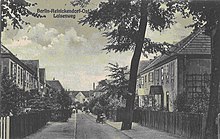Georg Heyer
Georg Max Heyer (born December 10, 1880 in Berlin ; † 1949 there ) was a German architect and building contractor .
Live and act
Born in 1880, Heyer was already running a construction business at the age of 24, based in the house at Regensburger Strasse 10a in Wilmersdorf, which was built in 1903 . From 1906 he lived and worked in his own house, Hedwigstrasse 3a in Schöneberg . In 1908, together with the architect A. Weber, he built the houses at Friedenauer Strasse 59–61 (now Hauptstrasse 83–85) in Schöneberg and moved into the house at Friedenauer Strasse 59 (now at Hauptstrasse 83). In 1916 Georg Heyer moved to Berlin-Schmargendorf at Breite Straße 46. From then on he also called himself an architect.
In several writings he published his thoughts on housing construction with the focus on economical construction and in connection with social housing reform. He saw the implementation of his ideas in a comprehensive change in land, house and housing management.
In 1919 he founded the "Luisenhof" Gemeinnützige Wohnungsbau AG , which built the Luisenhof estate in Berlin-Reinickendorf based on his design. Here he tried to realize his ideas about small houses for self-sufficient residents with rather low incomes.
In 1920 he acquired the site of a disused brickworks in Gildenhall near Neuruppin. A year later, he founded the Gildenhall eGmbH open-air settlement and began building settlement houses. He moved into one of them himself. Max Eckardt and Otto Bartning later took part in the construction of the settlement .
Georg Heyer returned to Berlin in 1926 and lived in Berlin-Prenzlauer Berg in the back building at Gleimstrasse 55. Two years later he moved to Flottwellstrasse 2. The German Garden City Society , founded in 1902 , the Worpswede settler school and the Berlin Association for Non-Profit Building Activities resided in the same building . After the economic failure with the Gildenhall project, he founded Georg Heyer Baugesellschaft GmbH in 1930 . The construction of four terraced houses on land that he had acquired from the Dahlem estate brought him financial ruin, his company was liquidated in 1932 and Georg Heyer was destitute and unemployed.
From 1934 he lived in Eisackstrasse 8 in Berlin-Schöneberg. The reform of housing construction remained his most important concern and so he published his publication “New Apartments - New Cities” in February 1945 (preprinted as a special supplement to the Bauwelt from December 15, 1944), in which he outlined his concept of post-war reconstruction through terraced housing estates and standardized and fire-bomb-proof residential building. Due to the circumstances of the last weeks of the war, however, his ideas were hardly noticed. After the end of the war he presented his structural plan for Berlin (Hermsdorfer Plan). In 1948 Georg Heyer was still doing so badly economically that he applied for financial aid from the magistrate. This was rejected, but the magistrate was willing to buy some of its urban development projects for a maximum of RM 15,000. Georg Heyer died in Berlin in 1949. Günter Kühne praised him in obituary as a town planner and social reformer. Apart from the works mentioned, his buildings are largely unknown today.
plant
buildings
- 1908: House in Berlin-Schöneberg, Hauptstrasse 83-85 (together with A. Weber)
- 1910–1911: House in Berlin-Wedding, Osloer Straße 116a
- 1919: Luisenhof settlement in Berlin-Reinickendorf, Luisenweg
- 1921–1925: Open-air housing estate in Neuruppin-Gildenhall (together with other architects)
- 1932: four row houses in Berlin-Dahlem, Ihnestrasse 38
Fonts
- Social housing reform means economical construction. Berlin 1918.
- Five-room small apartments in the terraced house of the Georg Heyer building business. Berlin 1919.
- New apartments, new cities. Berlin 1945.
- The Hermsdorf plan for a new Berlin. In: Neue Bauwelt , 1st year 1946, no.25.
- Criticism of the housing reformer. In: Die Neue Stadt, magazine for the design of town and country , year 1948, issue 2.
literature
- Kristina Bake: The Gildenhall open-air settlement. Crafts, life reform, social utopia. (= European university publications , art history, vol. 384.) Peter Lang Verlag, Frankfurt am Main 2001.
- Günter Kühne: Georg Heyer in memory. In: Die Neue Stadt, magazine for the design of town and country , year 1950, issue 2.
- Benno Dietrich: The utopians from Gildenhall . In: Märkische Oderzeitung online from April 6, 2011.
Web links
- The builder Georg Heyer on the website of the working group "Städtkranz Berlin-Brandenburg"
Individual evidence
- ↑ Birth register StA Berlin 7a, No. 6072/1880
- ^ Berlin address book, 1904.
- ^ Berlin address book, 1916.
- ^ Berlin address book, 1926
- ↑ Landesarchiv Berlin, A Pr.Br.Rep 042 No. 2780
- ↑ Landesarchiv Berlin, C Rep. 910-51
- ^ Johann Friedrich Geist, Klaus Kürvers: The Berlin tenement house 1945–1989. Berlin 1989, p. 183.
- ↑ Landesarchiv Berlin, F Rep. 280 - 8503/16 and C Rep. 100-05 - 815.
- ^ Günter Kühne: Georg Heyer to the memory . In: Die Neue Stadt 1950, no. 2.
- ^ Osloer Straße 116a, entry in the monument database
- ^ Friedrich Paulsen: The Luisenhof settlement . In: Die Bauwelt , 10th year 1919, issue 17, p. 8 f.
- ↑ Luisenhof settlement, entry in the monument database .
| personal data | |
|---|---|
| SURNAME | Heyer, Georg |
| ALTERNATIVE NAMES | Heyer, Georg Max |
| BRIEF DESCRIPTION | German architect and contractor |
| DATE OF BIRTH | December 10, 1880 |
| PLACE OF BIRTH | Berlin |
| DATE OF DEATH | 1949 |
| Place of death | Berlin |
